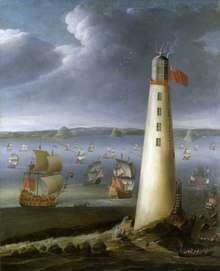HMS Aldborough (1706)
HMS Aldborough was a 24-gun sixth-rate ship of the Royal Navy, purchased in 1706 and in service in Mediterranean and English waters until 1727.
| History | |
|---|---|
| Name: | HMS Aldborough |
| Builder: | William Johnson, Blackwall |
| Launched: | 6 March 1706 |
| Acquired: | 2 January 1706 |
| Commissioned: | March 1706 |
| Out of service: | 29 March 1727 |
| Fate: | Broken up, Portsmouth dockyard |
| General characteristics | |
| Class and type: | 24-gun sixth-rate |
| Tons burthen: | 287 77/94 bm |
| Length: |
|
| Beam: | 26 ft 10.5 in (8.2 m) |
| Depth of hold: | 11 ft 1.5 in (3.4 m) |
| Propulsion: | Sail |
| Sail plan: | ship-rigged |
| Complement: | 115 |
| Armament: |
|
Naval career

Initially intended for merchant service, the as yet unnamed vessel was purchased for Naval use while still under construction at London's Blackwall Yard in January 1706.[1] After a brief refit she was commissioned as Aldborough in March and put to sea under Commander Beaumont Waldron. Later that year she was recorded as being off Ostend, and as part of the British presence in the Mediterranean in the winter of 1708. By spring she had returned to English waters for patrol and convoy duties. On 11 April she engaged and captured the French privateer Le Postillon.[1]
Waldron died in 1709 and Aldborough continued her home waters patrol under Captain Thomas Ekines. On 28 April 1710 she captured another privateer, La Genevieve de Bonne Esperance. A year later on 28 August 1711 she ran down and seized a third French ship, Le Desmarais. Despite Aldborough's victories, Ekines was dismissed as her captain in June 1712, and replaced by Captain Joseph Thornton.[1]
Eight years of active service had reduced Aldborough's seaworthiness, and in 1714 she underwent an expensive refit and repair at Portsmouth Dockyard.[lower-alpha 1][1] She returned to sea in 1715 under Captain Charles Stewart, whose orders were to patrol the waters surrounding Scotland and Ireland.
A further refit was required at Plymouth dockyard in the summer of 1717, after which Aldborough returned to her previous coastal patrol.[lower-alpha 2][1]
Charles Stewart died in 1718, and Aldborough's command passed to Captain Thomas Lawrence. The ship's final decade of service was uneventful, and on 29 March 1727 she was returned to Portsmouth dockyard for breaking up.[1] Her timbers and fittings were initially preserved with the intention that she be rebuilt and returned to active service, but this work was postponed by other demands. Over time, these materials were distributed among other naval ships in need of repair and a new Aldborough was commissioned in her stead.[3]
Notes
Footnotes
Citations
- Winfield 2007, p.244
- "Purchasing Power of British Pounds from 1264 to Present". MeasuringWorth. 2009. Retrieved 9 November 2014.
- Lavery, Brian (May 1980). "The Rebuilding of British Warships 1690-1740". The Mariner's Mirror. United Kingdom: Society for Nautical Research. 66 (2): 116.
Bibliography
- Winfield, Rif (2007). British Warships of the Age of Sail 1714–1792: Design, Construction, Careers and Fates. Seaforth. ISBN 9781844157006.